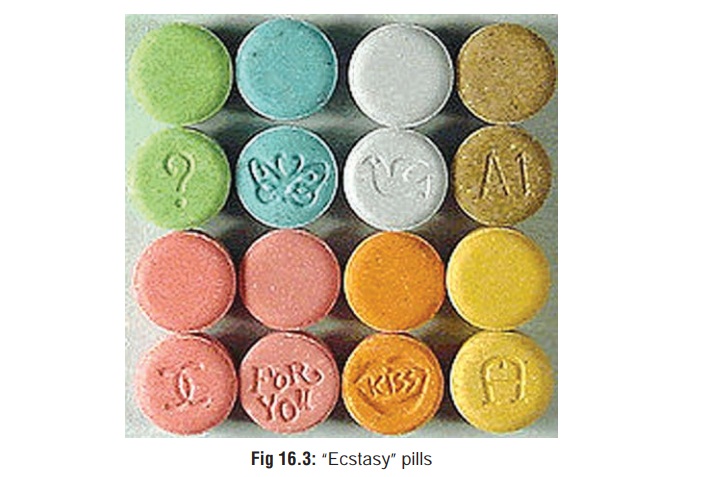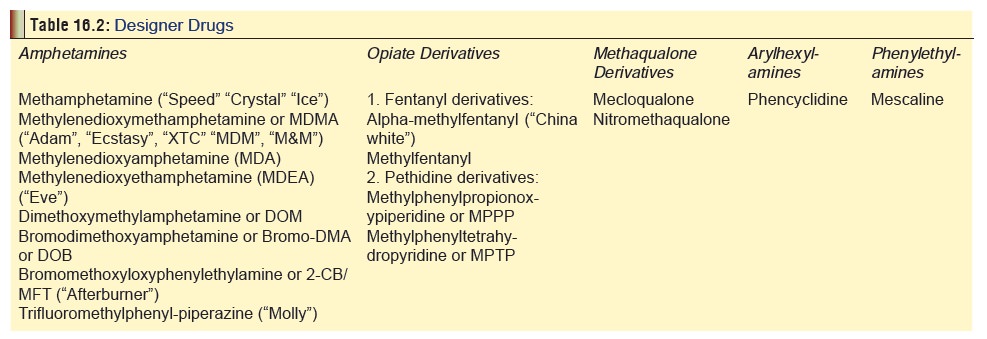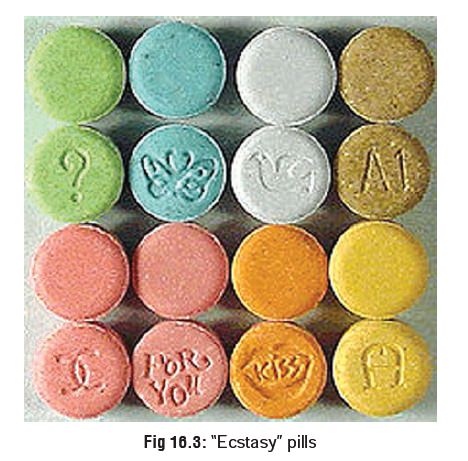Chapter: Modern Medical Toxicology: Neurotoxic Poisons: Stimulants
Designer Amphetamines - Stimulant Neurotoxic Poisons

Designer Amphetamines
Designer drugs are congeners of active compounds that have
been modified from legitimate pharmaceutical agents, and are used for
recreational purposes. Apart from amphetamines, there are several other groups
of designer drugs (Table 16.2),
which have been discussed in detail elsewhere. Designer drugs are usually
stronger and cheaper than the parent compound, and can be easily synthesised in
clandestine laboratories. The term routes of old drugs (e.g. cocaine used in
freebase form, i.e. “crack”). It also does not include legal drugs which are
abused (e.g. ephedrine, caffeine, phenylpropanolamine, etc.).
enedioxymethamphetamine, which was introduced by E Merck and Company in Germany
in 1914. However, it was never marketed. It was only in the 1970s and early
1980s that it made its appearance as an “underground” drug.* Since 1983 it has
become increasingly popular among adolescents and college students as a recreational
drug to be used during “rave parties” which are extended dance parties often
lasting all night long. The other designer amphetamines (Table 16.2) quickly followed and are mostly available as gelatin
capsules or loose powder for ingestion. They have made their way into India in
the late 1990s, and are quite openly abused by college students from affluent
families.

Mode of Action
While
designer amphetamines share a number of properties with the original
amphetamines, unlike the latter, they are potent releasers of serotonin.
Chronic administration can result in permanent damage to serotonergic neurons.
Uses
Methylenedioxymethamphetamine
(MDMA) was used in the early years following its synthesis, by psychologists to
enhance psychotherapy. Today, there are no legal uses for any of the designer
amphetamines.
Clinical Features
· Designer amphetamines are abused by
teenagers and young adults for inducing euphoria, facilitating intimacy and
verbosity, and heightening sexuality. Users of MDMA report that it “expands
consciousness” without making them lose control. Sometimes these drugs are
labeled “entactogens” for their alleged ability to increase sensitivity to
touch, or “empathicogens”, for their alleged ability to create empathy,
especially before sexual encounters. MDMA is considered an “entheogen” which
means “to become divine from within”. Entheogen refers to a state of shamanic
or ecstatic possession induced by ingestion of mind-altering drugs.
· “Candyflipping”
refers to the intentional combination of ecstasy with LSD. Another method of
use is called “stacking” in which 3
or more tablets of MDMA are taken at once; or MDMA is mixed with alcohol,
cannabis or some other drug (ketamine, GHB, cocaine, etc.) in order to modify
the “high”. Stacking can increase the risk of overdose, since MDMA, acting as a
stimulant, can mask the sedative effects of alcohol or any other drug. There is
current vogue for combining ecstasy with sildenafil to enhance sexual pleasure
(“sexstasy”).
·
Effects are seen 30 to 45 seconds after ingestion (on an
empty stomach) in the form of a ‘rush’, which lasts 15 to 30 minutes. This is
followed by a sense of clarity and joy. A booster dose may be taken at this
point, to prolong these feelings. About ½ hour to 3 hours after the initial
ingestion, a “plateau” phase occurs in which repetitive or trance-like
movements become extremely pleasur-able. The “coming down” phase occurs 3 to 6
hours after the initial ingestion, and can lead to negative feelings or
emotions (depression, anxiety). Symptoms may persist for several days.
· ![]() Acute toxicity results in nausea, anorexia, anxiety,
mydri-asis, hyperthermia, muscle rigidity, trismus, sinus tachy-cardia,
sweating, tachypnoea, cardiac arrhythmias, cardiac arrest, metabolic acidosis,
rhabdomyolysis, myoglobinuria, acute renal failure, and disseminated
intravascular coagula-tion. The following have also been reported: convulsions,
cerebral infarcts, hallucinations, paranoia, chest pain, hyperkalaemia, and
fulminant hepatic failure. Pulmonary oedema and ARDS may occur in severe
intoxications.
Acute toxicity results in nausea, anorexia, anxiety,
mydri-asis, hyperthermia, muscle rigidity, trismus, sinus tachy-cardia,
sweating, tachypnoea, cardiac arrhythmias, cardiac arrest, metabolic acidosis,
rhabdomyolysis, myoglobinuria, acute renal failure, and disseminated
intravascular coagula-tion. The following have also been reported: convulsions,
cerebral infarcts, hallucinations, paranoia, chest pain, hyperkalaemia, and
fulminant hepatic failure. Pulmonary oedema and ARDS may occur in severe
intoxications.
Coma
may develop in severe cases.
· Chronic use results in anorexia,
weight loss, exhaustion, jaundice, irritability, flashbacks, paranoia,
depression, or psychosis. However, since frequent use diminishes the
pleas-urable effects of these drugs, users often taken them only at intervals
of 2 to 3 weeks, and then gradually lose interest and stop intake altogether
over a period of time.* There appear to be no reports of individuals who take
excessive doses of these drugs frequently over an extended period of time.
· Ecstasy has been associated with
cardiovascular and muscu-loskeletal malformations in babies exposed in utero.
Treatment
Treatment
measures are essentially the same as for all ampheta-mine poisonings.
Medicosocial and Forensic Issues
·
Amphetamines are the most widely
used illicit drugs (second only to cannabis) in the United Kingdom, Australia,
and many parts of Europe. Significant abuse also occurs in the USA. After the
introduction of amphetamines into clinical use in the early 1930s, they were
available as prescription drugs for various indications (obesity, narcolepsy,
attention deficit disorder, psychotherapy), and even sold over the counter in
the form of nasal inhalers till the early 1970s. Since then their
pharmaceutical use has been greatly curtailed, though many of these drugs are
still available (under restric- tion) in Western countries. They are virtually
banned in India.
·
Japan experienced an epidemic of
intravenous metham- phetamine abuse in the years following the Second World
War. Crystalline methamphetamine (“ice”) was introduced in the 1980s in Hawaii,
and quickly became popular in other countries.
· Today, designer amphetamines are a rage among adolescent party-goers, and are used extensively in the course of “rave parties”. This fad has now gripped several metropolitan Indian cities where tablets of Ecstasy are available freely among elite circles (Fig 16.3). Much of this popularity has to do with the copious amount of information existing on these drugs on the Internet, and the fact that unlike certain other drugs like heroin and cannabis, designer drugs are considered “hep” and “cool”. Also, unlike many other hard drugs, designer drugs can be easily consumed (ingested) without the messiness of nasal insufflations, smoking, or injection.

·
Adulteration of MDMA tablets may be
done with oriental herbal ephedrine (Ma
Huang) or ketamine.
·
Paramethoxyamphetamine (PMA,
"death") a ring-substi- tuted amphetamine (methoxylated
phenethylamine deriva-tive) has been fraudulently marketed as MDMA, and has
caused several deaths.
Related Topics